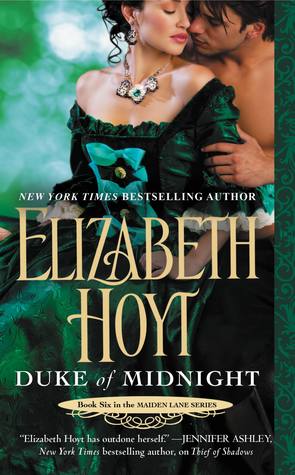Oh boy did I fall behind in November, but I had some fantastic (and some mundane) adventures during all that radio silence, and I read a lot of books. One of those books was Elizabeth Hoyt’s Duke of Midnight, which filled me with happy.
The blurb, courtesy of Goodreads…
WHEN A MASKED MAN . . .
Twenty years ago Maximus Batten witnessed the brutal murders of his parents. Now the autocratic Duke of Wakefield, he spends his days ruling Parliament. But by night, disguised as the Ghost of St. Giles, he prowls the grim alleys of St. Giles, ever on the hunt for the murderer. One night he finds a fiery woman who meets him toe-to-toe—and won’t back down . . .
MEETS HIS MATCH . . .
Artemis Greaves toils as a lady’s companion, but hiding beneath the plain brown serge of her dress is the heart of a huntress. When the Ghost of St. Giles rescues her from footpads, she recognizes a kindred spirit-and is intrigued. She’s even more intrigued when she realizes who exactly the notorious Ghost is by day . . .
DESIRE IGNITES A DANGEROUS PASSION
Artemis makes a bold move: she demands that Maximus use his influence to free her imprisoned brother-or she will expose him as the Ghost. But blackmailing a powerful duke isn’t without risks. Now that she has the tiger by the tail, can she withstand his ire-or the temptation of his embrace?
Batman pretty much wins when it comes to vaguely creepy masked vigilante characters, right? I mean, he’s a complete package: traumatic yet humanizing back story, honestly-earned grit, determination, physical strength, *almost* super human agility, etc, as well as a dank man cave in which he stores his vigilante gear (hopefully sans nipples) and keeps his body well honed. That’s loads more compelling than a humanoid alien whose body responds well to earth’s gravity or a scientist who gets bitten by a spider or some dude who finds a magic lantern.
Duke of Midnight is Elizabeth Hoyt’s historical romance nod to Batman canon, and it is equally compelling.
As the sixth (sixth!) book in her Maiden Lane series, I expected it to feel a bit tired, but it isn’t. Actually, I got the feeling reading it that Hoyt has been looking forward to telling this story for quite a while, and her excitement in (finally) writing it translates well to the reader. The characters are interesting and the story is as gripping as you’d expect a superhero story to be.
In fact, there were only a couple of things that I was a little bit bummed about (and one thing I was a lot bummed about):
- One of my favorite things about Hoyt’s novels is that she always weaves a legend throughout the story at the beginning of each chapter. The legend in this one wasn’t quite as compelling (to me) as previous ones.
- The ending felt a bit deus ex machina to me. One of the things that always happens to superheroes is that they’re forced to choose between saving a loved one and saving the masses. Seriously… it’s in like every superhero story. This book made it just a wee bit too easy on our intrepid hero to win both counts (although I did like how he made his choice so unequivocally…).
Finally, I was a lot bummed about Penelope. She’s a fairly awful secondary character who was quite unpleasant throughout the previous five books, but I always had a bit of a soft spot for her and held a hope that she’d find her redemption at some point. After all, even silly, spoiled girls eventually grow up, right? (I’m one of those people who believes even Lydia Bennet, eventually, developed a sense of self-reflection.) I was, therefore, rather heartbroken to see Penelope utterly outdo all her former awfulness in an epic display of poor character.
Maybe it’s not too late — maybe Penelope can still redeem herself — but it made me sad. I hate how women in fiction (even fiction written by women) are so often cast as either good or evil, and I liked how Penelope was a blend… too selfish to be truly good but too good-hearted to be truly evil. But after the way she behaves at the end of this book, her blend seems skewed towards the evil…
But, hey! That’s just me. All told, I had a blast reading the book and, though I haven’t talked about it at all in this review, I loved the romance between Maximus and Artemis, loved that Artemis was his equal in more ways than one, and I loved that the narrative didn’t ignore the ways in which they were unequal. Finally, I liked that they got to make a happy ending of it. (If a man had written it, Artemis would have been blown to bits so that Maximus could be super sad and continue being a vigilante. Thank God for Elizabeth Hoyt!)
Duke of Midnight was released on October 15, 2013 as an e-book and paperback by Forever. For more information about the book, please click on the cover image above to visit its page on Goodreads. For information on Elizabeth Hoyt, please check out her website or Twitter.
*FTC Disclosure – I received an e-galley of this book from Forever via NetGalley in exchange for an honest review.*





